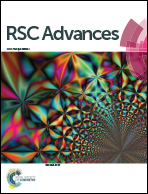Effect of drying conditions on the structure of three-dimensional N-doped graphene and its electrochemical performance
Abstract
Freeze drying is a general method for preparing three dimensional (3D) graphene based materials, however, in this paper, we used N-doped graphene as a model material and found that if the N-doped graphene hydrogel was pre-frozen, instead of an interconnected porous structure, a loosely packed layered structure was obtained. Furthermore, the effects of drying conditions on the pore and chemical structure have been discussed. Results demonstrated that when the graphene hydrogel was directly freeze dried, an interconnected porous structure can be obtained, whereas, heat dried and pre-frozen samples had layered structures. The structure determines the performance; the sample prepared by direct freeze drying with an interconnected porous structure had the highest specific capacitance of 218 F g−1 when the current density was 0.01 A g−1, and the specific capacitance still remained at about 85% of its initial value even at a high current density (1 A g−1). The excellent electrochemical performance is mainly attributed to the fast electrolyte diffusion paths provided by the interconnected porous channels.


 Please wait while we load your content...
Please wait while we load your content...